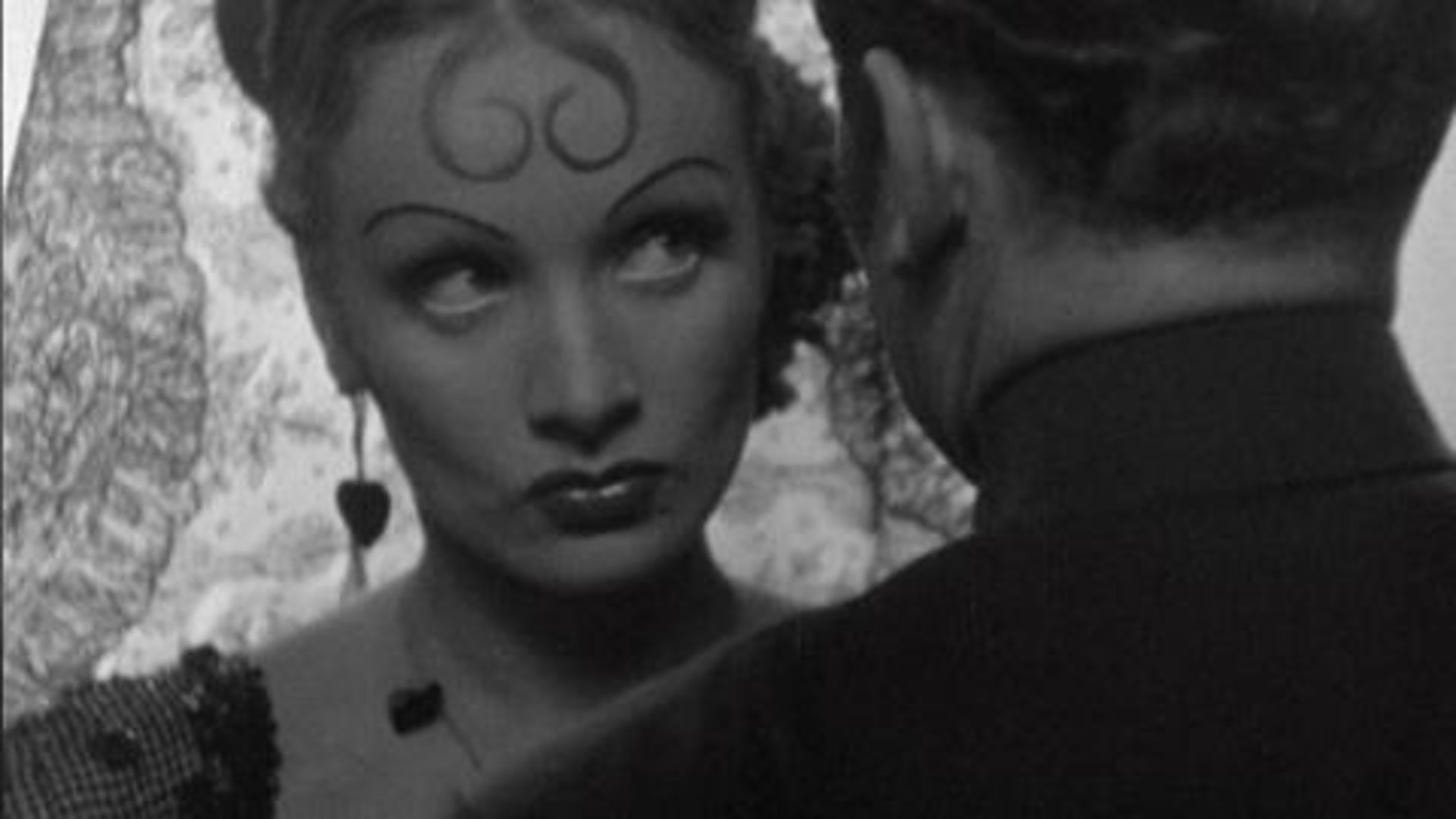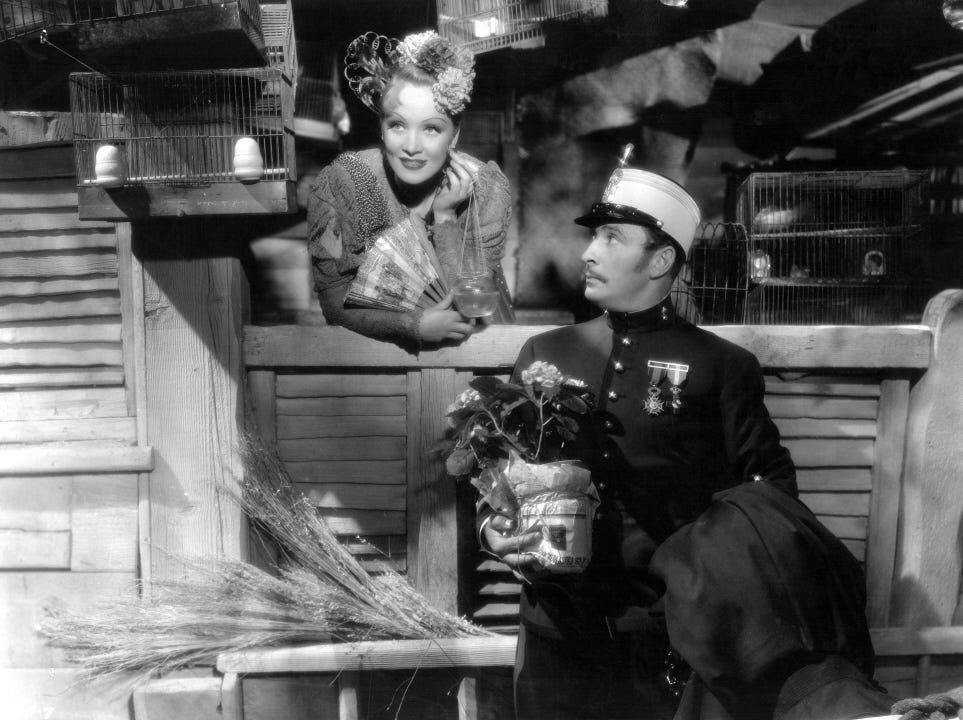Minding the Gaps: 'The Devil Is a Woman' (1935)
Marlene Dietrich and Josef von Sternberg's landmark seven-film collaboration reached an end with this tale of a Spanish femme fatale.
Minding the Gaps is a recurring feature in which Keith Phipps watches and writes about a movie he’s never seen before as selected at random by the app he uses to catalog a DVD and Blu-ray collection accumulated over the course of the last 20+ years. It’s an attempt to fill in the gaps in his film knowledge while removing the horrifying burden of choice. This is the third entry.
“Marlene watches from the wall
Her mocking smile says it all
As she records the rise and fall
Of every soldier passing” —Suzanne Vega, “Marlene on the Wall” (1985)
“Those pictures of me sitting on that barrel, they sell them all over the place and everyone’s mad about it and all the rest. And then… there are the impress—is that the word? Impersonators. And they impersonate me sitting on that barrel with my leg pulled up. It’s ridiculous. Well, it is.” —Marlene Dietrich, Marlene (1984)
In the early ‘80s, producer Karel Dirka had an opportunity and a problem. The opportunity: the chance to make a documentary about Marlene Dietrich. But that was also the problem. Dietrich, who made her last film appearance alongside David Bowie in 1979’s little-seen Just a Gigolo, didn’t want to be photographed. Possible directors like Orson Welles and Billy Wilder—both of whom had worked with and befriended Dietrich in the past—emerged and disappeared until the task fell to another of Dietrich’s old collaborators, actor Maximillian Schell.
Schell agreed to Dietrich’s no photography restriction, using her as an unseen voice accompanying clips and archival photos, but he still had to put up with other demands, like her resistance to the project in general, particularly its requirement that she reflect on her past. She told stories filled with half-truths (like a claim to be an only child despite Schell’s photographic proof of an older sister). An attempt to get Dietrich to comment on her old movies by screening clips with her proved especially disastrous, pushing Dietrich to the brink of anger (maybe beyond). Schell had been warned. Prior to that particular session, Dietrich’s manager snuck him a note with a quote from Dante’s Inferno: “There is no greater pain than the recollection of past happiness in times of misery.”
Marlene Dietrich, the senior citizen who spent her days signing autographs and reading piles of newspapers in her Paris flat, was over Marlene Dietrich, the movie star who became an international sensation as the obsession-stirring showgirl Lola Lola in Josef von Sternberg’s The Blue Angel. But the rest of the world wasn’t over Dietrich, who’d become iconic, not in the social media-debased meaning of the word but in the original sense. Her image was a symbol of some higher, intangible quality. She meant something. But what?
The Reveal is a reader-supported newsletter dedicated to bringing you great essays, reviews and conversation about movies (and a little TV). While both free and paid subscriptions are available, please consider a paid subscription to support our long-term sustainability.
That this remains a tough question to answer is itself a kind of answer. From her Blue Angel breakthrough in 1930—there were other movies before it, but none truly mattered—Dietrich has embodied elusiveness. In that film, Dietrich’s Lola drives previously upright bachelor professor Immanuel Rath (Emil Jannings) into debasement and, eventually, madness. He quits his job and marries her, but the marriage compounds his unhappiness rather than alleviating it. It’s never clear if Lola is truly “bad” or if Rath's undoing isn't mostly rooted in his obsession and jealousy. On screen, other characters could desire Dietrich but never truly know her, much less possess her. She played characters who rarely revealed their motives or let their true feelings show. She was removed, over it, disappointed but also alluring, despite seeming to put so little effort into stoking the desire of others when she appeared capable of lighting fires simply by entering the room. She knew something others didn’t, but what she’d never tell.
It was in The Blue Angel, too, that Dietrich sat on the barrel in the pose that would sell so many postcards. Posters too, one of which ended up on the wall of a young Suzanne Vega, who wrote a song about it that appeared on her self-titled 1985 debut album. “The lines came out of my life,” Vega told Song Talk in 1991 while declining to get into more details. The song doesn’t really demand them. Lovers come and go while Dietrich keeps watch, her expression unchanging, her judgment implied. She knows, or at least strongly suspects, it won’t end well.
On screen, it often didn’t, for Dietrich’s characters or those who tried to get close to her. She sinned and suffered and if she ended up paying the price, well, she knew it was coming or figured it out pretty quickly. Shanghai Express, a Best Picture nominee and one of the most popular films Dietrich and von Sternberg made in Hollywood, is an exception, but her character is no less worldly than those she played elsewhere. Its most famous line: “It took more than one man to change my name to Shanghai Lily.” (Abandoning her hooded eyes and dismissive frown for girlish enthusiasm, she’s almost unrecognizable in another exception, The Scarlet Empress, as the naive teen who’ll become the pitiless and insatiable Catherine the Great.)
All the while, von Sternberg provides the dramatic lighting, stunning compositions, and erotic charge that elevated their films into a kind of woozy dream state. Dietrich would later dismiss it all as “kitsch” and downplay her own work. “I wasn’t erotic,” she insisted to Schell. “I was snotty.” But however she felt in retrospect, to watch her is to watch an artist in full control of her craft, one who understands how the slightest shift in expression could change the mood of a scene and direct the course of a story.
When the app I use to select unseen movies from my collection at random offered up The Devil is a Woman, Dietrich and von Sternberg’s final film together, I didn’t think I’d have as much catching up to do as I ultimately did. Then I realized I’d only ever seen Shanghai Express and Morocco. So I binged the Dietrich/von Sternberg filmography, an undertaking I recommend doing for many reasons, not the least of which is that it offers a fascinating study in movie stardom. Dietrich played everyone from the Empress of Russia to, in Blonde Venus, a an immigrant cabaret singer-turned-prostitute. Sometimes the characters were pure of heart no matter how lurid their deeds. Sometimes, as in The Devil is a Woman, they were mostly wicked. But Dietrich was never about range. From film to film she does little to alter her persona despite that broad array of characters. Yet that persona is somehow still flexible enough to fit each role.
Much unites the collaborative work of von Sternberg and Dietrich but it’s impossible to choose a representative film. Set largely in early 20th century Seville, The Devil is a Woman finds Dietrich playing Concha Pérez, an unapologetic femme fatale who sets her sights on the dashing Antonio (Cesar Romero), a revolutionary she meets at Carnival. Most of the film consists of Antonio being warned away from Concha by Don Pasqual (Lionel Atwill) by way of flashbacks detailing all the times she seduced and took advantage of him only to return and do it again. Pasqual is not a dumb man, but Dietrich makes his repeated duping thoroughly believable.
The pleasure comes from watching her be bad, and it’s considerable, though, as with The Scarlet Empress before it, audiences stayed away at the time, leaving future generations to reassess and reclaim it. Though, to my eyes the least of the von Sternberg/Dietrich pairings, it’s deservedly been canonized.* It might have been Blue Angel-era Dietrich who ended up on those postcards, but the iconic value never shifted over the course of her career, both on screen and later as a touring singer: she’s a woman who’s dangerous, lovely, weary, and complicated in ways no mere mortal could ever untangle.
About those postcards: I went to college over a decade after Vega, but “Marlene on the Wall” marks us both as a member of the same pale subset who decorated our personal space with venerations of yesteryear’s artistic heroes. Let others have Cindy Crawford or that shirtless guy holding a baby. Give us Groucho Marx, Virginia Woolf, William Blake and Brigitte Bardot. They served as a shorthand for something we admired in the world and maybe something we wanted, or wanted to be. Maybe, as with Dietrich, it was something we knew to be a little dangerous. The real figures might grow old and dismissive. But the images that inspired those feelings could never change.
Next: Cherry 2000 (1988)
* A quick ranking, though all are pretty great:
Morocco
The Blue Angel
Shanghai Express
The Scarlet Empress
Blonde Venus
Dishonored
The Devil Is a Woman







Funnily enough, one performer I had on my wall as a late teenager was Suzanne Vega.
Great piece Keith, really enjoy these looks back.